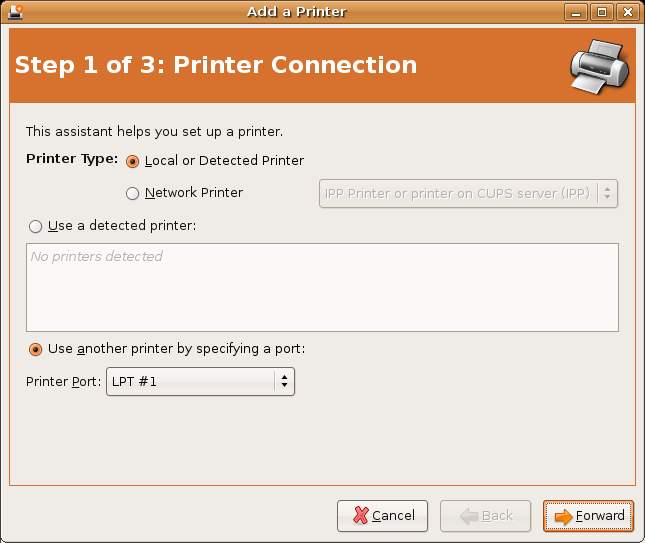Configuring Ubuntu Linux Printers
Despite predictions to the contrary, we are still a long way achieving the concept of the paperless office. It is quite common, therefore, to need to connect a printer to a computer system. With this in mind, this chapter will be devoted to covering the steps required to add printer access to an Ubuntu Linux system. Printers may be connected directly to an Ubuntu Linux system, accessed over a network or attached to a Windows system on the network.
As with many aspects of system administration Ubuntu Linux makes the installation of a printer straightforward and fast.
Installing a Directly Connected Printer
By far the easiest type of printer configuration is when the printer is attached directly to the system via a parallel, serial or USB port. To configure a locally attached printer invoke the Printers dialog by selecting the System desktop menu and choosing Printing from the Administration menu. The resulting dialog will list installed printers, together with a New Printer icon:
Double click on the New Printer icon to invoke the Add a Printer dialog (shown below). The application will scan the system and list any printers it finds. If no printers are detected make sure the cable to the printer is securely connected, and that the printer is switched on. If the printer is still not detected select the port to which the printer is connected using the Use another printer by specifying a port option and selecting the appropriate port.
Having selected the detected printer or port click the Forward button to select the appropriate printer driver. On the resulting screen select the printer manufacturer and choose the model from the list. Click on the Forward button to install the appropriate driver for the printer:
Click the Forward button and enter the optional printer description and location information. You should be returned to the Printers dialog where your new printer should be listed.
Once the driver is installed you are ready to try out the printer. In the Printers dialog select your printer, right click with the mouse to pop up the menu and select Properties. Click on Print Test Page to send a test page to the printer.
Configuring a Printer Connected to a Windows System
If you need to access a printer which is connected to a Windows system you can easily configure Ubuntu Linux to support this. The first step is to visit the Windows system and make sure the printer is shared and find out the share name. On Windows XP select Printers and Faxes from the Start menu and find your printer. Right click on the printer and select Sharing. In the properties dialog select Share this printer if it has not already been selected. Enter a Share name or note the name if one already exists. Then return to your Ubuntu Linux system.
Invoke the Printers dialog (System desktop menu->Administration->Printing). Double click on New Printer and select Network Printer. Since the printer is connected to a Windows system, select Windows Printer (SMB) from the drop down menu. Enter the host name or IP address of the Windows system on which the printer is installed. The Printer field, enter the shared name you noted down from the Windows system. Click Forward and install the driver for the printer model.
Once installed right click with the mouse on the new printer in the Printers dialog, select Properties and click on the Print Test Page button. A test page should then appear on the printer.
Detecting LAN Printers
To detect a LAN printer open the Printers dialog (System dekstop menu->Administration->Printing). In the printers dialog, click on the Global Settings menu option and click on Detect LAN Printers. If any printers connected to Linux or UNIX systems on the network are configured to be shared, they will be listed in the Printers dialog. If the printer you need to access is not listed, make sure that it is shared. Assuming the remote system is an Ubuntu Linux system, go to that system, invoke the Printers dialog and select Share Printers from the Global Settings menu.
Configuring a Printer Connected to a Remote System
Ubuntu Linux fully supports printing to printers connected to other remote Linux systems. If automatically detecting LAN printers as described above failed to locate the printer you need to install, you can configure it manually. To do so, invoke the Printers dialog (System desktop menu->Administration->Printing). Double click on New Printer and select Network Printer. Since the remote computer is a Linux system, select IPP Printer or Printer on CUPS Server from the drop down menu. Enter the URI of the printer on the remote system. This will be something similar to:
ipp://hostname:631/printers/printername
Where hostname is the either the hostname or IP address of the remote system on which the printer is installed and printername is the name of the printer on that system. Click Forward and install the driver for the printer model.
Once installed, right click with the mouse on the new printer in the Printers dialog, select Properties and click on the Print Test Page button. A test page should then appear on the printer.


